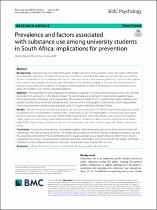Prevalence and factors associated with substance use among university students in South Africa: implications for prevention
Abstract
Background: Substance use is an important public health concern in many countries across the globe. Among the general public, institutions of higher learning have developed a reputation for inducing new substance use among students. In addition to socio-demographic factors, substance use and abuse among university students often appear to be related to psychological stressors typically related to the demand to adapt to the new environment and the pressures associated with academia. The purpose of this study was to identify the prevalence of, and factors associated with substance use among university students. Methods: This quantitative study employed convenience sampling to recruit university students who were 18 years and older from a university in the Western Cape. The study made use of self-administered online questionnaires, which participants completed via SurveyMonkey. The sample consisted of 2915 students. Descriptive statistics were used to describe and provide the prevalence and overview of the demographic characteristics of the respondents. Associations between variables were explored using Chi-square and Mann–Whitney U tests. Results: The main findings revealed a substance use prevalence rate of 62.7%. The most prominent substances used by students were alcohol (80.6%), cannabis (46%), and ecstasy (5.3%). The study further revealed clear associations between students’ substance use and mental health. Students who reported substance use at university reported higher depression and anxiety scores than those who did not. However, findings reveal no significant association (p = 0.233) between being a substance user and a nonsubstance user and students' respective self-perceived stress scores. Conclusion: Results show the majority of sampled students had started using substances (both alcohol and other substances) only after entering university. The results call into question seminal findings relating to substance use and the university environment. The novel findings of this study could serve as a baseline input to inform policymakers, programme developers, service providers, parents, and other stakeholders who are involved in the design and implementation of more effective awareness, prevention and, needs-based intervention services.

